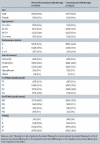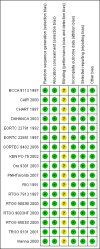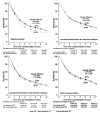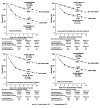Hyperfractionated or accelerated radiotherapy for head and neck cancer
- PMID: 21154350
- PMCID: PMC8407183
- DOI: 10.1002/14651858.CD002026.pub2
Hyperfractionated or accelerated radiotherapy for head and neck cancer
Abstract
Background: Several trials have studied the role of altered fractionation radiotherapy in head and neck squamous cell carcinoma, but the effect of such treatment on survival is not clear.
Objectives: The aim of this individual patient data (IPD) meta-analysis was to assess whether this type of radiotherapy could improve survival.
Search strategy: We searched the Cochrane Ear, Nose and Throat Disorders Group Trials Register; CENTRAL (2010, Issue 3); PubMed; EMBASE; CINAHL; Web of Science; BIOSIS Previews; Cambridge Scientific Abstracts; ISRCTN and additional sources for published and unpublished trials. The date of the most recent search was 8 August 2010.
Selection criteria: We identified randomised trials comparing conventional radiotherapy with hyperfractionated or accelerated radiotherapy, or both, in patients with non-metastatic head and neck squamous cell carcinomas and grouped trials into three pre-specified treatment categories: hyperfractionated, accelerated and accelerated with total dose reduction. Trials were eligible if they began recruitment after 1969 and ended before 1998.
Data collection and analysis: We obtained updated individual patient data. Overall survival was the main outcome measure. The secondary outcome measures were local or regional control rates (or both), distant control rates and cause-specific mortality.
Main results: We included 15 trials with 6515 patients. The median follow up was six years. Tumour sites were mostly oropharynx and larynx; 5221 (74%) patients had stage III-IV disease (UICC 2002). There was a significant survival benefit with altered fractionation radiotherapy, corresponding to an absolute benefit of 3.4% at five years (hazard ratio (HR) 0.92, 95% CI 0.86 to 0.97; P = 0.003). The benefit was significantly higher with hyperfractionated radiotherapy (8% at five years) than with accelerated radiotherapy (2% with accelerated fractionation without total dose reduction and 1.7% with total dose reduction at five years, P = 0.02). There was a benefit in locoregional control in favour of altered fractionation versus conventional radiotherapy (6.4% at five years; P < 0.0001), which was particularly efficient in reducing local failure, whereas the benefit on nodal control was less pronounced. The benefit was significantly higher in the youngest patients (under 50 year old) (HR 0.78, 95% CI 0.65 to 0.94), 0.95 (95% CI 0.83 to 1.09) for 51 to 60 year olds, 0.92 (95% CI 0.81 to 1.06) for 61 to 70 year olds, and 1.08 (95% CI 0.89 to 1.30) for those over 70 years old; test for trends P = 0.007).
Authors' conclusions: Altered fractionation radiotherapy improves survival in patients with head and neck squamous cell carcinoma. Comparison of the different types of altered radiotherapy suggests that hyperfractionation provides the greatest benefit. An update of this IPD meta-analysis (MARCH 2), which will increase the power of this analysis and allow for other comparisons, is currently in progress.
Conflict of interest statement
Sanofi‐Aventis had a general agreement with Institut Gustave Roussy to support meta‐analyses on lung and head and neck cancers. Sanofi‐Aventis played no role in the study design, data collection, data analysis, data interpretation or writing of the publications. Sanofi‐Aventis is a pharmaceutical company with, to the best of the authors' knowledge, no interest in radiotherapy material.
We declare that we have no conflict of interest.
H Andrzej is deceased; no declaration of interest available.
Figures















Update of
References
References to studies included in this review
BCCA 9113 1997 {published and unpublished data}
-
- Jackson SM, Weir LM, Hay JH, Tsang VH, Durham JS. A randomized trial of accelerated versus conventional radiotherapy in head and neck cancer. Radiotherapy and Oncology 1997;43(1):39‐46. - PubMed
CAIR 2000 {published and unpublished data}
-
- Skladowski K, Maciejewski B, Golen M, Pilecki, B, Przeorek W, Tarnawski R. Randomized clinical trial on 7‐days‐continuous accelerated irradiation (CAIR) of head and neck cancer – report on 3‐year tumor control and normal tissue toxicity. Radiotherapy and Oncology 2000;55:101‐10. - PubMed
CHART 1997 {published and unpublished data}
-
- Dische S, Saunders M, Barrett A, Harvey A, Gibson D, Parmar M. A randomized multicentre trial of CHART vs conventional radiotherapy in head and neck cancer. Radiotherapy and Oncology 1997;44:123‐36. - PubMed
DAHANCA 2003 {published and unpublished data}
-
- Overgaard J, Hansen HS, Specht L, Overgaard M, Grau C, Andersen E, et al. Five compared with six fractions per week of conventional radiotherapy of squamous‐cell carcinoma of head and neck: DAHANCA 6&7 randomised controlled trial. Lancet 2003;362(9388):933‐40. - PubMed
EORTC 22791 1992 {published and unpublished data}
-
- Horiot JC, Fur R, N'Guyen T, Chenal C, Schraub S, Alfonsi S, et al. Hyperfractionation versus conventional fractionation in oropharyngeal carcinoma: final analysis of a randomized trial of the EORTC cooperative group of radiotherapy. Radiotherapy and Oncology 1992;25:231‐41. - PubMed
EORTC 22851 1997 {published and unpublished data}
-
- Horiot JC, Bontemps P, Bogaert W, Fur R, Weijngaert D, Bolla M, et al. Accelerated fractionation compared to conventional fractionation improves locoregional control in the radiotherapy of advanced head and neck cancer: results of the EORTC 22851 randomized trial. Radiotherapy and Oncology 1997;44:111‐21. - PubMed
GORTEC 9402 2006 {published and unpublished data}
-
- Bourhis J, Lapeyre M, Tortochaux J, Rives M, Aghili M, Bourdin S, et al. Phase III randomized trial of very accelerated radiation therapy compared with conventional radiation therapy in squamous cell head and neck cancer: a GORTEC trial. Journal of Clinical Oncology 2006;24:2873‐8. - PubMed
KBN PO 79 2002 {published and unpublished data}
-
- Hliniak A, Gwiazdowska B, Szutkowski Z, Kraszewska E, Kukolowicz P, Jarzabski A, et al. A multicenter randomized/controlled trial of a conventional versus modestly accelerated radiotherapy in the laryngeal cancer: influence of a 1 week shortening overall time. Radiotherapy and Oncology 2002;62:1‐10. - PubMed
Oro 9301 2003 {published and unpublished data}
-
- Olmi P, Crispino S, Fallai C, Torri V, Rossi F, Bolner A, et al. Locoregionally advanced carcinoma of the oropharynx: conventional radiotherapy versus accelerated hyperfractionated radiotherapy versus concomitant radiotherapy and chemotherapy ‐ a multicenter randomized trial. International Journal of Radiation Oncology, Biology, Physics 2003;55:78‐92. - PubMed
PMHToronto 2007 {published data only}
-
- Cummings B, Keane T, Pintilie M, Warde P, Waldron J, Payne D, et al. Five year results of a randomized trial comparing hyperfractionated to conventional radiotherapy over four weeks in locally advanced head and neck cancer. Radiotherapy and Oncology 2007;85(1):7‐16. - PubMed
RIO 1991 {published data only}
-
- Pinto LH, Canary PC, Araujo CM, Bacelar SC, Souhami L. Prospective randomized trial comparing hyperfractionated versus conventional radiotherapy in stage III and IV oropharyngeal carcinoma. International Journal of Radiation Oncology, Biology, Physics 1991;21:557‐62. - PubMed
RTOG 7913 1987 {published and unpublished data}
-
- Marcial VA, Pajak TF, Chang C, Tupchong L, Stetz J. Hyperfractionated photon radiation therapy in the treatment of advanced squamous cell carcinoma of the oral cavity, pharynx, larynx, and sinuses, using radiation therapy as the only planned modality: (preliminary report) by the Radiation Therapy Oncology Group (RTOG). International Journal of Radiation Oncology, Biology, Physics 1987;13:41‐7. - PubMed
RTOG 9003B 2000 {published data only}
-
- Fu KK, Pajak TF, Trotti A, Jones CU, Spencer SA, Phillips TL, et al. A radiation therapy oncology group (RTOG) phase III randomized study to compare hyperfractionation and two variants of accelerated fractionation to standard fractionation radiotherapy for head and neck squamous cell carcinomas: first report of RTOG 9003. International Journal of Radiation Oncology, Biology, Physics 2000;48:7‐16. - PubMed
RTOG 9003HF 2000 {published and unpublished data}
-
- Fu KK, Pajak TF, Trotti A, Jones CU, Spencer SA, Phillips TL, et al. A radiation therapy oncology group (RTOG) phase III randomized study to compare hyperfractionation and two variants of accelerated fractionation to standard fractionation radiotherapy for head and neck squamous cell carcinomas: first report of RTOG 9003. International Journal of Radiation Oncology, Biology, Physics 2000;48:7‐16. - PubMed
RTOG 9003S 2000 {published data only}
-
- Fu KK, Pajak TF, Trotti A, Jones CU, Spencer SA, Phillips TL, et al. A radiation therapy oncology group (RTOG) phase III randomized study to compare hyperfractionation and two variants of accelerated fractionation to standard fractionation radiotherapy for head and neck squamous cell carcinomas: first report of RTOG 9003. International Journal of Radiation Oncology, Biology, Physics 2000;48:7‐16. - PubMed
TROG 9101 2001 {published and unpublished data}
-
- Poulsen MG, Denham JW, Peters LJ, Lamb DS, Spry NA, Hindley A, et al. A randomised trial of accelerated and conventional radiotherapy for stage III and IV squamous carcinoma of the head and neck: a Trans‐Tasman Radiation Oncology Group Study. Radiotherapy and Oncology 2001;60:113‐22. - PubMed
Vienna 2000 {published and unpublished data}
-
- Dobrowsky W, Naudé J. Continuous hyperfractionated accelerated radiotherapy with/without mitomycin C in head and neck cancer. Radiotherapy and Oncology 2000;57:119‐24. - PubMed
References to studies excluded from this review
Awwad 2002 radical RT {unpublished data only}
-
- Awwad HK. Personal communication 2002.
Datta 1989 {published data only}
-
- Datta NR, Dutta Choudhry A, Gupta S, Bose AK. Twice a day versus once a day radiation therapy in head and neck cancer. International Journal of Radiation Oncology, Biology, Physics 1989;17(Suppl 1):132‐3.
Overgaard 1989 {published data only}
-
- Overgaard J, Hansen HS, Andersen AP, Hjelm‐Hansen M, Jorgens K, Sandberg E, et al. Misonidasole combined with split course radiotherapy in the treatment of invasive carcinoma of larynx and pharynx: report from the DAHANCA 2 study. International Journal of Radiation Oncology, Biology, Physics 1989;16:1065‐8. - PubMed
Sanchiz 1990 {published data only}
-
- Sanchiz F, Milla A, Torner J, Bonet F, Artola N, Carreno L, et al. Single fraction versus two fractions per day versus radio‐chemotherapy in the treatment of HNSCC. International Journal of Radiation Oncology, Biology, Physics 1990;19:1347‐50. - PubMed
Skladowski 2007 {published and unpublished data}
-
- Sladowski K, Hutnik M, Wygoda A, Sasiadek W, Rutkowski T, Golen M, et al. Two accelerated radiation treatments have produced identical acute mucosal toxicity profile. An interim report on CAIR‐2 Phase III trial for head and neck cancer patients. Radiotherapy and Oncology 2007;82(Suppl 1):S86‐7.
Tandon 1999 {published data only}
-
- Tandon N, Keshwar TS, Srivastava M, Mali HR. Continuous hyperfractionated accelerated radiotherapy (CHART) in head and neck malignancies. 15th Asia Pacific Cancer Conference; Chennai, India. 1999.
Van den Bogaert 1986 {published data only}
-
- Bogaert W, Schueren E, Horiot JC, Chaplain G, Vilhena M, Raposo S, et al. Early results of the EORTC randomized clinical trial on multiple fraction per day (MFD) and misonidazole in advanced head and neck cancer. International Journal of Radiation Oncology, Biology, Physics 1986;12:587‐91. - PubMed
Weissberg 1982 {published data only}
-
- Weissberg JB, Son YH, Percarpio B, Fischer JJ. Randomized trial of conventional versus high fractional dose radiation therapy in the treatment of advanced head and neck cancer. International Journal of Radiation Oncology, Biology, Physics 1982;8:179‐85. - PubMed
Wiernik 1991 {published data only}
-
- Wiernik G, Alcock CJ, Bates TD, Brindle JM, Fowler JF, Gajek WR, et al. Final report on the second British Institute of Radiology fractionation study: short versus long overall treatment times for radiotherapy of carcinoma of the laryngo‐pharynx. British Journal of Radiology 1991;64:232‐41. - PubMed
References to ongoing studies
Ang 2001 {published data only}
-
- Ang KK, Trotti A, Brown BW, Garden AS, Foote RL, Morrison WH, et al. Randomized trial addressing risk feature and times factors of surgery plus radiotherapy in advanced head and neck cancer. International Journal of Radiation Oncology, Biology, Physics 2001;51:571‐8. - PubMed
Ang 2010 {published data only}
ARTSCAN II {published data only}
-
- Preoperative accelerated versus postoperative conventional radiotherapy in patients with resectable cancer of the oral cavity. http://www.controlled‐trials.com/ISRCTN00608410/00608410 (accessed 30 September 2010).
Awwad 1992 {published data only}
-
- Awwad HK, Khafagy Y, Barsoum M, Ezzat S, El‐Attar I, Farag H, et al. Accelerated versus conventional fractionation in the postoperative irradiation of locally advanced head and neck cancer: influence of tumour proliferation. Radiotherapy and Oncology 1992;25:261‐6. - PubMed
Awwad 2002 {published data only}
-
- Awwad HK, Lotayef M, Shouman T, Begg AC, Wilson G, Bentzen SM, et al. Accelerated hyperfractionation (AHF) compared to conventional fractionation (CF) in the postoperative radiotherapy of locally advanced head and neck cancer: influence of proliferation. British Journal of Cancer 2002;86:517‐23. - PMC - PubMed
Bartelink 2002 {published data only}
-
- Bartelink H, Bogaert W, Horiot JC, Jager J, Glabbeke M. Concomitant cisplatin and radiotherapy in a conventional and modified fractionation schedule in locally advanced head and neck cancer: a randomised phase II EORTC trial. European Journal of Cancer 2002;38:667‐73. - PubMed
Bourhis 2010 {published data only}
-
- Bourhis J, Sire C, Lapeyre M, Gregoire V, Maingon P, Calais G, et al. Accelerated versus conventional radiotherapy with concomitant chemotherapy in locally advanced head and neck carcinomas: results of a phase III randomized trial. Radiotherapy and Oncology 2010;72 (Suppl 1):S32.
Dische 2007 {published data only}
-
- Dische S, Saunders M. Phase III randomized study of adjuvant continuous hyperfractionated accelerated radiotherapy versus conventional radiotherapy in patients with head and neck cancer. PDQ database 2007.
Ezzat 2005 {published data only}
-
- Ezzat M, Shouman T, Zaza K, Safwat A, El‐Khoudary A, El‐Senosi M, et al. A randomized study of accelerated fractionation radiotherapy with and without mitomycin C in the treatment of locally advanced head and neck cancer. Journal of the Egyptian National Cancer Institute 2005;17:85‐92. - PubMed
Ghosh 2006 {published data only}
-
- Ghosh S, Agarwal J, Bhutani R, Vora A, Prabhash K, D'cruz A, et al. Randomized trial of conventional fractionated RT (CFRT) vs. concomitant chemo radiotherapy (CTRT) and accelerated radiotherapy (ACRT) in patients with advanced, non nasopharyngeal, squamous cell cancers of the head and neck region. International Journal of Radiation Oncology, Biology, Physics 2006;66(Suppl 1):S191.
Horiot 2007 {published data only}
-
- Horiot JC. EORTC 22962: Phase III comparison study of conventional vs hyperfractioned radiotherapy in head and neck squamous cell carcinoma with or without concomitant chemotherapy. PDQ database 2007.
Johnson 1995 {published data only}
-
- Johnson CR, Schmidt‐Ullrich RK, Arthur DW, Huang DT, Duffy EW. Standard once daily versus thrice‐daily concomitant boost accelerated superfractionated irradiation for advanced squamous cell carcinoma of the head and neck: preliminary results of a prospective randomized trial. International Journal of Radiation Oncology, Biology, Physics 1995;32:162.
Krstevska 2006 {published data only}
Langendijk 2007a {published data only}
-
- Langendijk J, on behalf of the NWHHT‐SG. The Dutch head and neck cancer cooperative study group (NWHHT‐SG). Radiotherapy and Oncology 2007;82(Suppl 1):S1.
Langendijk 2007b {published data only}
-
- Langendijk J, on behalf of the NWHHT‐SG. The Dutch head and neck cancer cooperative study group (NWHHT‐SG). Radiotherapy and Oncology 2007;82(Suppl 1):S1.
Overgaard 2010 {published data only}
-
- Overgaard J, Mohanti BK, Begum N, Ali R, Agarwal JP, Kuddu M, et al. Five versus six fractions of radiotherapy per week for squamous‐cell carcinoma of the head and neck (IAEA‐ACC study): a randomised, multicentre trial. Lancet Oncology 2010;11(6):553‐60. - PubMed
Sanguineti 2005 {published data only}
-
- Sanguineti G, Richetti A, Bignardi M, Corvo' R, Gabriele P, Sormani MP, et al. Accelerated versus conventional fractionated postoperative radiotherapy for advanced head and neck cancer: results of a multicenter phase III study. International Journal of Radiation Oncology, Biology, Physics 2005;61:762‐71. - PubMed
Sastri 2008 {published data only}
-
- Ghoshal S, Goda JS, Mallick I, Kehwar TS, Sharma SC. Concomitant boost radiotherapy compared with conventional radiotherapy in squamous cell carcinoma of the head and neck ‐ a phase III trial from a single institution in India. Clinical Oncology 2008;20(3):212‐20. - PubMed
Slevin 2002 {published data only}
-
- Slevin NJ. A randomised two arm trial of modestly accelerated radiotherapy with synchronous cisplatinum chemotherapy versus conventional radiotherapy with synchronous cisplatinum chemotherapy in the treatment of head and neck squamous cell carcinoma: a pilot study. http://www.controlled‐trials.com/ISRCTN86478952/86478952 (accessed 28 September 2010).
Suwinski 2008 {published data only}
-
- Suwinski R, Bankowska‐Wozniak M, Majewski W, Idasiak A, Maciejewski A, Ziólkowska E, et al. Randomized clinical trial on 7‐days‐a‐week postoperative radiotherapy for high‐risk squamous cell head and neck cancer. Radiotherapy and Oncology 2008;87(2):155‐63. - PubMed
Trotti 2006 {published data only}
Zackrisson 2007 {published data only}
-
- Zackrisson B, Kjellén E, Björk‐Eriksson T, Friesland S, Reizenstein J, Lagerlund M, et al. Preliminary results from a Swedish study of conventional versus accelerated fractionated of squamous carcinoma of the head and neck (ARTSCAN). Radiotherapy and Oncology 2007;82(Suppl 1):S1‐2.
Additional references
Bourhis 2004
-
- Bourhis J, Armand C, Pignon JP, on behalf of the MACH‐NC Collaborative Group. Update of MACH‐NC (Meta‐Analysis of Chemotherapy in Head & Neck Cancer) database focused on concomitant chemo‐radiotherapy. Proceedings of the American Society for Clinical Oncology 2004;22:488.
EBCT‐CG 1992
-
- Early Breast Cancer Trialists’ Collaborative Group. Systemic treatment of early breast cancer by hormonal, cytotoxic, or immune therapy: 133 randomised trials involving 31,000 recurrences and 24,000 deaths among 75,000 women. Lancet 1992;339:1‐15. - PubMed
EBCT‐CG 1995
-
- Early Breast Cancer Trialists’ Collaborative Group. Effects of radiotherapy and surgery in early breast cancer: an overview of randomized trials. New England Journal of Medicine 1995;333:1444‐55. - PubMed
Ferlay 2004
-
- Ferlay J, Bray F, Pisani P, Parkin DM. GLOBOCAN 2002: cancer incidence, mortality and prevalence worldwide. IARC Cancer Base. Vol. 5, version 2.0, Lyon, France: IARC Press, 2004.
Handbook 2009
-
- Higgins JPT, Green S (editors). Cochrane Handbook for Systematic Reviews of Interventions Version 5.0.2 [updated September 2009]. The Cochrane Collaboration, 2008. Available from www.cochrane‐handbook.org.
Higgins 2002
-
- Higgins JPT, Thompson SG. Quantifying heterogeneity in a meta‐analysis. Statistics in Medicine 2002;21:1539‐58. - PubMed
Khalil 2003
-
- Khalil AA, Bentzen SM, Bernier J, Saunders MI, Horiot JC, Bogaert W, et al. Compliance to the prescribed dose and overall treatment time in five randomized clinical trials of altered fractionation in radiotherapy for head‐and‐neck carcinomas. International Journal of Radiation Oncology, Biology, Physics 2003;55:568‐75. - PubMed
NSCLC‐CG 1995
Pignon 2000a
-
- Pignon JP, Bourhis J, Domenge C, Designe L. Chemotherapy added to locoregional treatment for head and neck squamous‐cell carcinoma: three meta‐analyses of updated individual data. Lancet 2000;355:949‐55. - PubMed
Pignon 2007
-
- Pignon JP, Maître A, Bourhis J, on behalf of the MACH‐NC Collaborative Group. Meta‐analyses of chemotherapy in head and neck cancer (MACH‐NC): an update. International Journal of Radiation Oncology, Biology, Physics 2007;69(Suppl 1):S112‐4. - PubMed
Schemper 1996
-
- Schemper M, Smith TL. A note on quantifying follow‐up in studies of failure time. Controlled Clinical Trials 1996;17:343‐6. - PubMed
Stewart 1993
-
- Stewart LA, Parmar MK. Meta‐analysis of the literature or meta‐analysis of individual patient data: is there a difference?. Lancet 1993;341:418‐22. - PubMed
UICC 2002
-
- Sobin LH, Wittekind C. International Union Against Cancer (UICC): TNM Classification of Malignant Tumours. 6th Edition. New‐York: Wiley‐Liss, 2002.
Yusuf 1985
-
- Yusuf S, Peto R, Lewis J, Collins R, Sleight T. Beta blockade during and after myocardial infarction: an overview of randomised clinical trials. Progress in Cardiovascular Diseases 1985;27:335‐71. - PubMed
References to other published versions of this review
Bourhis 2006
-
- Bourhis J, Overgaard J, Audry H, Ang KK, Saunders M, Bernier J et al on behalf of MARCH Collaborative Group. Hyperfractionated or accelerated radiotherapy in head and neck cancer: a meta‐analysis. Lancet 2006;368:843‐54. - PubMed
Publication types
MeSH terms
LinkOut - more resources
Full Text Sources
Medical

